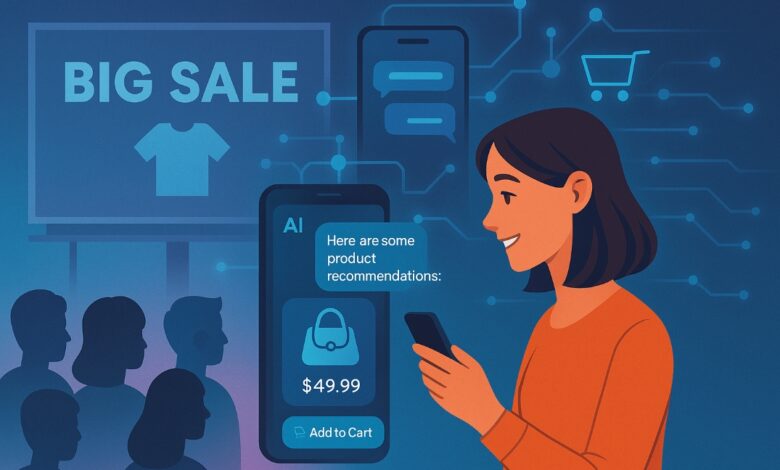
Artificial intelligence has become the connective thread of modern marketing. It is reshaping how consumers discover products, interact with brands, and make purchasing decisions. Social media, search, and influencer marketing now converge with AI-powered platforms, creating immediate, personalized, and transactional experiences.
From Mass Messaging to Hyper-Personalization
Marketing once relied on broad audience categories and one-size-fits-all campaigns. Today, AI enables brands to deliver personalized experiences at scale. Algorithms analyze browsing patterns, engagement history, and even tone preference to tailor messages to individual consumers.
A Gen Z shopper might see playful short-form video ads on TikTok, while a professional searching on LinkedIn might encounter data-backed thought leadership content. Relevance has become the new competitive edge, and AI makes such personalization possible in real time.
Yet personalization has limits. If it feels intrusive, consumers push back. Brands that explain how data is used and offer choices in personalization will earn more trust than those that simply maximize algorithmic targeting.
The New Commerce Layer
OpenAI’s in-chat shopping transforms ChatGPT from an advisory tool into a commerce platform. Users can ask for recommendations, see curated options, and complete a purchase without leaving the conversation. Discovery, evaluation, and checkout now happen within the same dialogue.
The customer journey is no longer linear but conversational. A question that begins with curiosity can end in a purchase in just a few exchanges. For marketers, the point of inquiry has become the point of sale.
This acceleration also brings responsibility. Chat-based systems must avoid obscuring details about shipping, returns, and warranties. Research shows that consumer trust in AI recommendations depends heavily on transparency and the ability to verify sources. Brands that embed safeguards such as visible sourcing and clear policies will gain an advantage in customer loyalty.
Influencers in the Age of Intelligent Automation
Influencer marketing has grown into a global market projected to reach USD 32.55 billion in 2025, up from about USD 24 billion in 2024. AI is accelerating this growth by helping brands identify the right creators, forecast ROI, and optimize campaigns.
Influencers are no longer just storytellers. Their posts, reviews, and videos become data inputs that conversational systems use when answering consumer questions. Imagine a fitness creator reviewing a smartwatch. Later, when a shopper asks an AI agent “Which smartwatch is best for swimming workouts?”, that influencer’s review may shape the response.
AI also enhances campaign execution. It can test variations of influencer content, refine calls to action, and monitor engagement patterns in real time. This makes campaigns more efficient and measurable. Yet authenticity remains the foundation of influencer value. Overreliance on automation risks stripping away the human connection that audiences seek. The future lies in balance: AI provides precision and scale, while influencers provide the relatability and trust that machines cannot replicate.
Search and Discovery in the Conversational Era
Search has undergone one of its most profound transformations since the beginning of digital advertising. Traditional search relied on keywords and ranked results. Today, generative AI powers conversational discovery that is contextual, predictive, and iterative.
Instead of typing “best skincare for dry skin”, a user might ask, “Which skincare routine is best for dry skin in winter and safe for sensitive skin?” The response is no longer a list of links but a synthesized answer with product recommendations and follow-up suggestions.
Google’s “Ask Stores” feature makes this shift concrete by embedding chat directly into Shopping results. Shoppers can refine queries such as availability or price inside a conversational panel rather than scrolling through static listings. For brands, product descriptions and FAQs are no longer just marketing copy. They are fuel for AI agents to deliver trusted responses in real time.
Google’s E-E-A-T (Experience, Expertise, Authoritativeness, and Trustworthiness) principles matter more than ever, as AI-driven search prioritizes expertise and trustworthiness.
Frameworks for the Future
Three guiding frameworks can help organizations adapt:
Conversational Readiness
Prepare content for consumption by both humans and machines. FAQs, product descriptions, and influencer narratives should be structured for clear, credible extraction.
Content and Commerce Convergence
Design every asset with commerce in mind. Videos, reviews, and blogs should include pricing, availability, or calls to action so users can move directly from engagement to purchase.
Attribution Beyond Clicks
Conversational journeys compress touchpoints. A consumer might see an influencer video, query ChatGPT, and complete a purchase in minutes. Attribution models must evolve to capture which content fragments or prompts drove the decision.
Conclusion
AI-powered customer experiences are no longer about automating after the fact. They are about embedding intelligence into every touchpoint of discovery, interaction, and purchase.
The implication is clear. Search, social, and commerce are merging into one interactive layer. The organizations that succeed will treat every touchpoint as both a discovery channel and a potential point of sale. They will optimize not only for visibility but for dialogue, trust, and immediate conversion.
While AI promises efficiency and personalization, overreliance on automation carries risks. Consumers quickly detect when interactions feel robotic or insincere. Automation can also dilute creativity if brands rely too heavily on machine-generated content that lacks nuance. Poor oversight may allow misinformation or bias to slip into automated systems, harming reputation and alienating audiences.
The most effective organizations use AI as an enabler rather than a replacement. Automation manages repetitive, high-volume tasks, while humans provide empathy, originality, and ethical oversight.
From personalized social content to conversational search and influencer campaigns enhanced by intelligent automation, the future of engagement will be defined by immediacy and trust. The challenge for brands is to balance innovation with responsibility. Brands that design experiences in the same ways consumers now use AI will reach the right people with positive engagement, driving business outcomes when and where it is relevant. Those that embed transparency and authenticity into AI-powered experiences will not only win conversions but also long-term loyalty.





